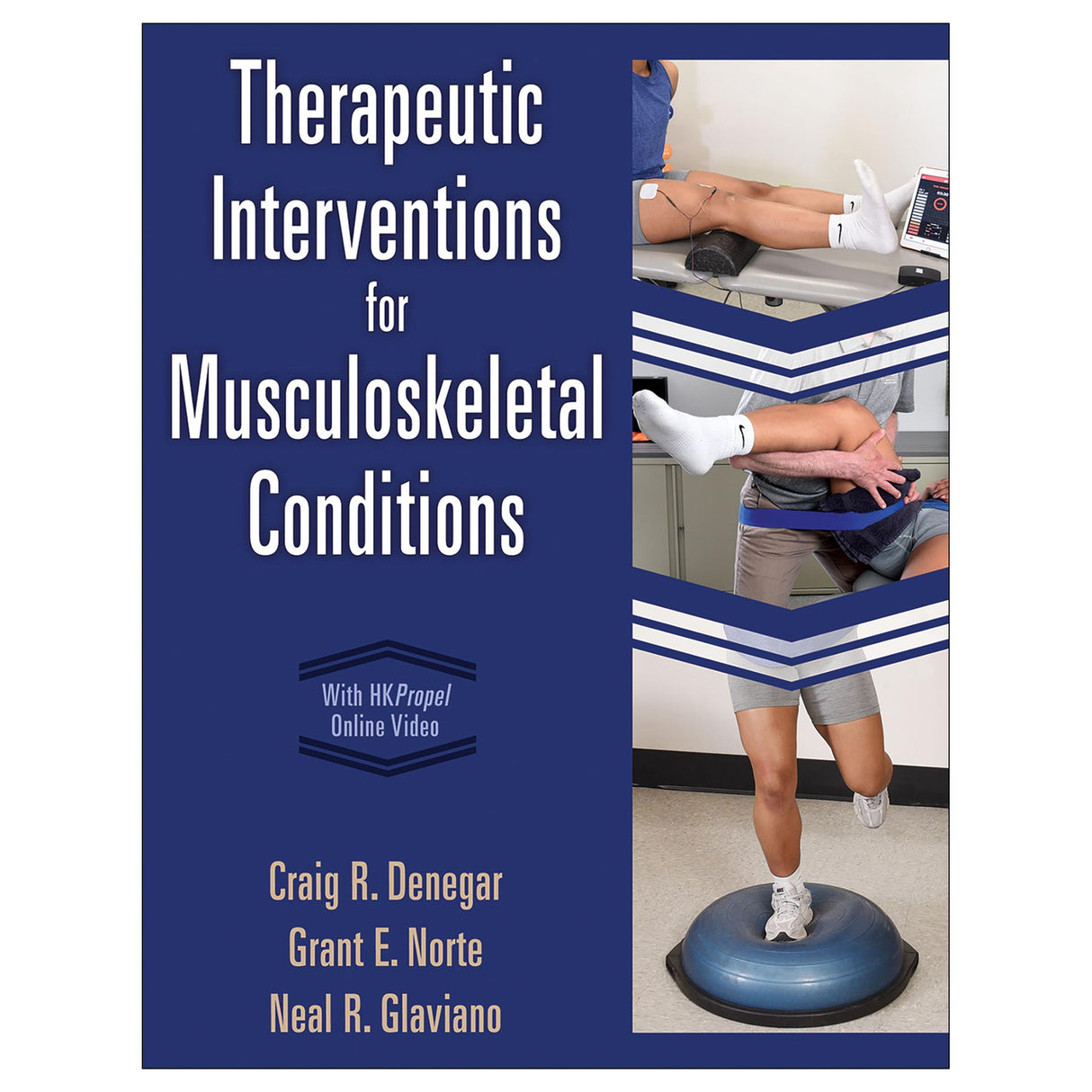Therapeutic Interventions for Musculoskeletal Conditions With HKPropel Online Video
This title will be released on January 29, 2026
$119.00 USD
A patient-focused text on interventions for musculoskeletal conditions.
With a modern approach that reaches beyond application of isolated modalities to manage injuries, Therapeutic Interventions for Musculoskeletal Conditions With HKPropel Online Video presents a multimodal perspective on treatment that considers all aspects of the patient’s experience. This contemporary, patient-centered approach to therapeutic interventions closely resembles clinical practice and offers insights on how and why physical agents, manual therapies, and therapeutic exercises should be applied for an optimal plan of care.
To provide a comprehensive understanding of treatment options and implications, the book features full-color medical illustrations that show joint mechanoreceptors, neurophysiological processes, and physiological responses to interventions. Students can also refer to 27 related online videos that demonstrate how to apply evidence-based therapeutic interventions for musculoskeletal conditions, including the use of physical agents, manual therapy, and neuromuscular reeducation.
Therapeutic Interventions for Musculoskeletal Conditions features a case study that builds upon itself in each part, taking the student from the beginning of a plan of care at the initial evaluation of an injury and through the various steps and progressions of treatment. This unique approach helps the student see how interventions can be implemented, progressed upon, and used in conjunction with each other.
Split into five parts, each section of Therapeutic Interventions for Musculoskeletal Conditions walks students through a phase of patient recovery:
- Part I covers the initial evaluation and creation of a plan of care.
- Part II discusses the neurophysiology behind pain transmission, signal modulation, tissue injury, inflammation, and pain science.
- Part III focuses on understanding limitations in range of motion and discusses various therapeutic modalities and manual interventions used to restore motion.
- Part IV highlights the importance of neuromuscular control in the healing process and ways to facilitate recovery.
- Part V explores the role of mechanical signaling and exercise in tissue recovery.
Students and professionals alike will develop stronger decision-making skills when determining the safest and most effective use of different treatment methods with Therapeutic Interventions for Musculoskeletal Conditions.
Note: A code for accessing online videos is included with all new print books.
Audience
Graduate students studying athletic training or physical therapy.
Part I. Clinical Reasoning
Chapter 1. Patient Examination and Evaluation
Defining the Problem
The Diagnostic Process
Biopsychosocial Models of Health
Patient Self-Report Instruments
Psychological Considerations in Musculoskeletal Care
Summary
Chapter 2. Developing the Plan of Care
Clinical Decision Making
Steps in Developing the Plan of Care
Goal Setting With the SMART Framework
Selecting the Appropriate Intervention
Documentation when Developing a Plan of Care
Summary
Part II. Pain
Chapter 3. Pain Transmission, Sensation, and Signal Modulation
The Pain Experience
Acute, Persisting, or Chronic Pain
Peripheral Sensory Receptors and Nociception
Afferent Nerves and Pain Signal Transmission
Pathways for Transmission of Nociceptive Pain
Sensory Integration
Pain Signal Modulation
Summary
Chapter 4. Tissue Injury, Inflammation, Nociception, and Healing
Tissue and Injury
Immediate Response to Injury
Inflammation
Triggering Nociceptive Pain and Initiating Repair
Tissue-Specific Healing
Factors Influencing Tissue Healing
Summary
Chapter 5. Pain Science and Patient Education
Nociplasticity and Sensitization
Explaining Pain
Summary
Chapter 6. Clinical Management of Pain
Cold
Superficial Heating
Transcutaneous Electrical Nerve Stimulation (TENS)
Manual Therapies
Therapeutic Ultrasound
LASER
Summary
Chapter 7. Pain Management and Exercise
Exercise Recommendations and Medical Exercise Therapy
Exercise and Pathological Pain
Exercise Prescription Considerations
Components of Exercise Prescription
Tips for Prescribing Exercise
Summary
Part III. Restoring Motion
Chapter 8. Impaired Range of Motion
Causes of Impaired Motion
Hypomobility, Joint Health, and Biomechanics
Plan of Care for Motion Restrictions
Summary
Chapter 9. Manual Therapies
Informed Consent, Contraindications, and Precautions
Positioning and Soft Tissue Techniques
Clinical Decisions in Positional and Soft-Tissue Techniques
Joint Mobilization
Clinical Decisions in Joint Mobilization Techniques
Exercise
Summary
Chapter 10. Facilitating Motion With Therapeutic Modalities
Superficial Heat
Therapeutic Ultrasound
Diathermy
Traction
Summary
Part IV. Neuromuscular Control
Chapter 11. Muscle Weakness, Atrophy, and Neuromuscular Impairment
Origins of Muscle Weakness
Origins of Muscle Atrophy
Origins of Impaired Proprioception and Neuromuscular Control
Summary
Chapter 12. Therapeutic Modalities to Facilitate the Restoration of Strength and Neuromuscular Function
Therapeutic Adjuncts to Exercise
Focal Joint Cooling
Transcutaneous Electrical Nerve Stimulation
Neuromuscular Electrical Stimulation
Blood Flow Restriction
Biofeedback
Vibration Therapy
Timing Considerations
Summary
Chapter 13. Exercise Prescription to Improve Strength and Neuromuscular Control
Avoiding Common Misconceptions in Therapeutic Exercise Programming
Contemporary Therapeutic Considerations
Emerging Therapeutic Considerations
Integration and Maintenance of the Plan of Care
Summary
Part V. Repair and Mechanobiology
Chapter 14. Mechanical Signaling and Tissue Homeostasis
Foundational Principles and Mechanisms of Mechanobiology
Mechanobiology in Musculoskeletal Tissues
Summary
Chapter 15. Exercise and Therapeutic Modalities as Stimuli for Tissue Repair
Tissue Specific Loading Considerations
Therapeutic Modalities
Summary
 Factors affecting clinical decision making
Factors affecting clinical decision making Roll and glide
Roll and glide Somatosensory contributions to the sensorimotor system
Somatosensory contributions to the sensorimotor system Motor points and electrical stimulation
Motor points and electrical stimulationAll ancillaries are free to adopting instructors through HKPropel.
Instructor guide. Includes chapter-specific files that contain the chapter objectives, summary, lecture outline, and three to five activity ideas.
Test package. Contains 30 questions per chapter in true-false, fill-in-the-blank, essay and short-answer, and multiple-choice formats. The files may be downloaded for integration with a learning management system or printed for use as paper-based tests. Instructors may also create their own customized quizzes or tests from the test bank questions to assign to students directly through HKPropel. Multiple-choice and true-false questions are automatically graded, and instructors can review student scores in the platform.
Chapter quizzes. Contains ready-made quizzes (10 questions each) to assess student comprehension of the most important concepts in each chapter. Each quiz may be downloaded or assigned to students directly through HKPropel. The chapter assessments are automatically graded, and instructors can review student scores in the platform.
Presentation package. Features more than 390 PowerPoint slides of text, artwork, and tables from the book that can be used for class discussion and presentation. The slides in the presentation package can be used directly within PowerPoint or printed to make handouts for students. Instructors can easily add, modify, and rearrange the order of the slides.
Image bank. Includes most of the figures, photos, and tables from the text, sorted by chapter. These can be used in developing a customized presentation based on specific course requirements.
Instructors also receive access to all student materials in HKPropel. For Therapeutic Interventions for Musculoskeletal Conditions, this includes access to online videos.






